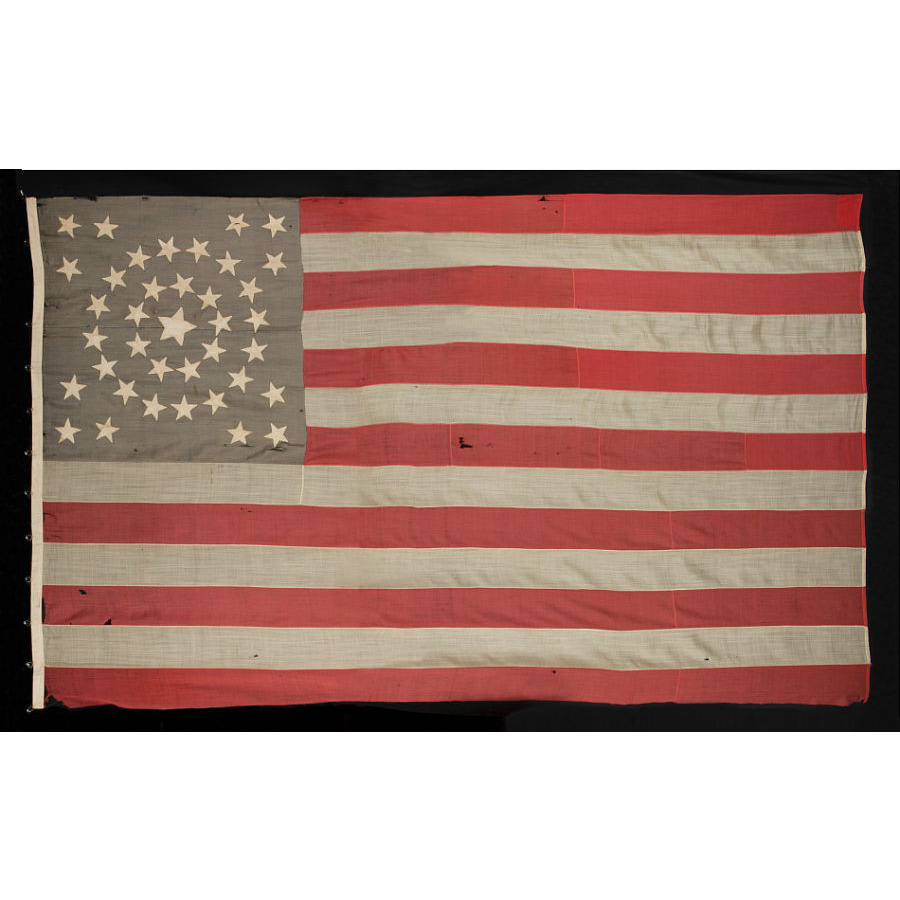
| |
38 STARS IN A MEDALLION CONFIGURATION WITH A RARE GROUPING OF 3 STARS IN EACH CORNER, 1876-1889, COLORADO STATEHOOD |
|
| Available: |
Sold |
| Frame Size (H x L): |
|
| Flag Size (H x L): |
85" x 136" |
|
| Description....: |
|
38 star American national flag in a large size with some unusual and attractive features. The stars are arranged in a medallion pattern that consists of two concentric wreaths of stars, surrounding a larger center star, with triangular groups of three stars flanking in each corner. A traditional medallion design has one, two, or three wreaths, with a star in the center and just one star in each corner. Variations on this design with multiple stars in each corner are much more rare and usually more visually interesting. That is the case with this example, where the entire device looks a bit like a giant gear, or maybe the footprint of a large round building with four pointed towers. Whatever the case may be to any given observer, it's safe to say that it's both beautiful and distinctly different from the norm, which makes it both desirable and academically intriguing. One theory on the use of triangles of three stars in a centennial era flag is that the illustration might represent the tri-corner hats so popular with patriots during the Revolutionary War. This could as easily be fiction as fact, but since there was no official star pattern for the flag in early America, many examples exist where liberties appear to have been taken by the makers of flags to include various types of patriotic and political symbolism.
The canton of the flag and the white stripes are made of wool bunting, while the red stripes are made of fine, merino wool. The stars are made of cotton and double-appliqued, meaning that they are applied to both sides of the canton. All of the piecework and applique work was done with a treadle machine. There is a sailcloth canvas binding along the hoist, along which are 13 brass rings, through which a rope would have been threaded for hoisting. The binding was applied with a treadle machine and the rings were hand-sewn with a whip stitch.
Note how the color of the blue canton has faded to a dusty blue-green. This is due to the use of a fugitive dye, more so than to light exposure and the passage of time. The result is a flag with an interesting color and patina that shows its age in what some call a very desirable fashion.
Colorado became the 38th state on August 1st, 1876. This was the year of our nation’s 100-year anniversary of independence. Per the Third Flag Act of 1818, stars were not officially added until the 4th of July following a state's addition. For this reason, 37 was the official star count for the American flag in 1876. Flag-making was a competitive venture, however, and few flag-makers would have been continuing to produce 37 star flags when their competitors were making 38’s. It is for this reason that 38 and 13 stars (to represent the original 13 colonies) are more often seen at the Centennial International Exposition, the six-month long World’s Fair held in Philadelphia in honor of the event. Some flag-makers would have been adding a star for the 38th state even before it entered the Union, in the early part of 1876 or even prior. In fact, many makers of parade flags were actually producing 39 star flags, in hopeful anticipation of the addition of two more Western Territories instead of one. But the 39th state would not join the Union for another 13 years, when the Dakota Territory entered as two states on the same day. The 38 star flag became official on July 4th, 1877 and was generally used until the addition of the Dakotas in 1889.
Decorative star patterns, like this one, tend to be seen on 38 star flags that were made specifically for the centennial.
President Ulysses S. Grant was in office when the first 38 star flags would have appeared. The list of presidents serving during the period when the 38 star flag was actually official include Rutherford B. Hayes, James Garfield, Chester Arthur, Grover Cleveland, and Benjamin Harrison.
Mounting: The flag has not yet been mounted. We employ professional staff with masters degrees in textile conservation and can attend to all of your mounting and framing needs.
Condition: There are minor tears and losses throughout, accompanied by very minor foxing and staining. Use of a fugitive dye in the canton has caused it to fade to a dusty blue-green. This is not exactly a bad trait among collectors. I have clients that actually prefer flags with cantons in this shade, which tend to look terrific on a black mount. many of my clients prefer flags that show their age and history of use. |
|
|
|
| Collector Level: |
Advanced Collectors and the Person with Everything |
|
| Flag Type: |
Sewn flag |
|
| Star Count: |
38 |
|
| Earliest Date of Origin: |
1876 |
|
| Latest Date of Origin: |
1889 |
|
| State/Affiliation: |
Colorado |
|
| War Association: |
1866-1890 Indian Wars |
|
| Price: |
SOLD |
|
| |
Views: 2402 |
|
|
|

